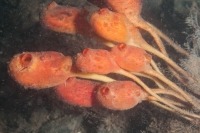
(Photo: Claire Goodwin)
Sea Potato
Boltenia ovifera
This solitary sea squirt consists of an orange, ball-shaped body up to eight centimetres long and attached by a long stalk to the seabed. The stalk can be two to four times the length of the body.
Authority
Linnaeus, 1767
Classification Details
Phylum: Chordata (chordates); Subphylum: Tunicata (tunicates); Class: Ascidiacea (sea squirts).
Habitat
Found in the Arctic and North Atlantic on rocky seabeds from 10 to 300 metres deep, associated with areas with strong tidal currents. Numbers have declined significantly in the Bay of Fundy in recent years. Sea potatoes can be seriously damaged by bottom fishing.
Diet
Suspension feeders. Feed on small particles in the seawater, including plankton and detritus. They take in water through their inhalant siphons and trap particles from the seawater in a mucus net that lines the pharynx. The net is then made into a mucus rope to pass food to the stomach.
Reproduction
Hermaphrodites - individuals are both male and female. They release sperm and eggs through their exhalant siphons. Fertilization occurs in the seawater. The planktonic larvae eventually settle on the seabed. Adults live for up to three years.
Fun Facts
Lots of different animals and seaweeds grow on sea potatoes (22 different species were found in a recent study in Nova Scotia!). Young cod are often found amongst sea potatoes, hiding from their predators.
The sea potato’s Latin name ovifera means egg-shaped.
References
Francis F, Filbee-dexter K, Scheibling R (2014) Stalked tunicates Boltenia ovifera form biogenic habitat in the rocky subtidal zone of Nova Scotia. Marine Biology 161, 1375–1383. doi: 10.1007/s00227-014-2425-7. G Gosner KL (1978) A field guide to the Atlantic seashore. Peterson field guide no. 24. Houghton Mifflin Company: Boston, New York. Kenchington E, Kenchington TJ, Henry L, Fuller S and Gonzalez P (2007) Multi–decadal changes in the megabenthos of the Bay of Fundy: The effects of fishing. Journal of Sea Research 58, 220–240.

